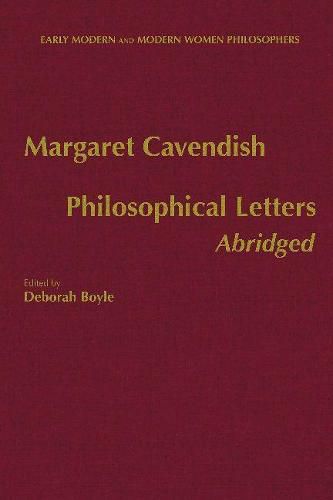Readings Newsletter
Become a Readings Member to make your shopping experience even easier.
Sign in or sign up for free!
You’re not far away from qualifying for FREE standard shipping within Australia
You’ve qualified for FREE standard shipping within Australia
The cart is loading…






Margaret Cavendish (1623–1673) is a fascinating figure who is getting increasing attention by historians of philosophy these days, and for good reason… . She’s an interesting advocate of a vitalist tradition emphasizing the inherent activity of matter, as well as its inherent perceptive faculties. She’s also the perfect character to open students (and their teachers) up to a different seventeenth century, and a different cast of philosophical characters. This is an ideal book to use in the classroom . The Philosophical Letters (1664) gives us Cavendish’s view of what was interesting and important in the philosophical world at that moment, a view of philosophy as it was at the time by an engaged participant. There are few documents like it in the history of philosophy . Deborah Boyle’s Introduction provides a very accessible summary of Cavendish’s natural philosophy, as well as good introductions to the other figures that Cavendish discusses in the book. Boyle’s annotations are not extensive, but they are a great help in guiding the student toward an informed reading of the texts. -Daniel Garber, Princeton University
$9.00 standard shipping within Australia
FREE standard shipping within Australia for orders over $100.00
Express & International shipping calculated at checkout
Margaret Cavendish (1623–1673) is a fascinating figure who is getting increasing attention by historians of philosophy these days, and for good reason… . She’s an interesting advocate of a vitalist tradition emphasizing the inherent activity of matter, as well as its inherent perceptive faculties. She’s also the perfect character to open students (and their teachers) up to a different seventeenth century, and a different cast of philosophical characters. This is an ideal book to use in the classroom . The Philosophical Letters (1664) gives us Cavendish’s view of what was interesting and important in the philosophical world at that moment, a view of philosophy as it was at the time by an engaged participant. There are few documents like it in the history of philosophy . Deborah Boyle’s Introduction provides a very accessible summary of Cavendish’s natural philosophy, as well as good introductions to the other figures that Cavendish discusses in the book. Boyle’s annotations are not extensive, but they are a great help in guiding the student toward an informed reading of the texts. -Daniel Garber, Princeton University